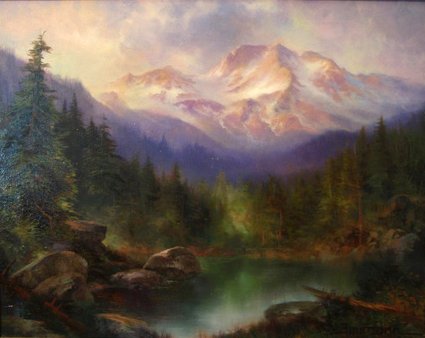The Trees of Castle Crag Lake – Attributes of a Tree
Because we are experiencing unusually mild weather here in Mt. Shasta, we have been able to venture into some of the most beautiful landscapes in America. One of the jewels in the crown is Castle Lake, a high mountain lake located just west of the town of Mt. Shasta. Students attending my workshops especially enjoy painting at this location because of the exceptional beauty of this alpine lake. Its convenient location allows artists to drive and park near her shore, set up their easels, and begin painting. On the day that we came to the lake, the midday sun backlit the trees, creating an unusual effect against the cool wash of the background wall of rocks. This effect of light caught my eye and I knew that I wanted to capture it in this little painting.
When painting trees in nature it is more important to capture the essence of the trees than just the texture of the foliage. In many plein air paintings, I notice that artists place too much attention on the amount of paint that they apply rather than how they apply their paint. What is more important in painting landscapes is to capture credibly the nature of how trees and plants grow and appear in their environment.
For example, carefully examine the attributes of a tree. When looking at a tree, notice its energy and how it shoots up out of the ground, how the branches reach outward to the sky, and how the limbs pull down to the earth as they flow away from the tree. Notice how elastic the limbs are, because elasticity in the limbs indicates the tree’s strength, its growth, and how it lives in its environment. Observe the tops of the trees and notice how the sprays stretch high towards the heavens; observe the motion and the energy of the wind and atmosphere that exists high in the trees.
These details tell the story of the tree, its history, and its place in a landscape. Painting just the texture of a tree does not tell the viewer how it looks right now. It is like painting a portrait of an old woman without wrinkles. It may be painted to look pretty, but the result may not be interesting or revealing. It is the lines and wrinkles in her face that tells the story of how she lived, laughed, and loved.
I believe that these details are missing in many plein air paintings today. In the background of my painting, I have included subtle details embedded in the sheer cliffs, and you can see lines in the crags that mark its stratification. You can also see how it has been washed and rounded by glaciers and weather, and that it is not just a wall of rock. The main reason that artists first moved from the studio into the wilderness was to be able to carefully observe and record nature with their own eyes, because without close observation and the use of details, painting can become mechanical and oversimplified.

